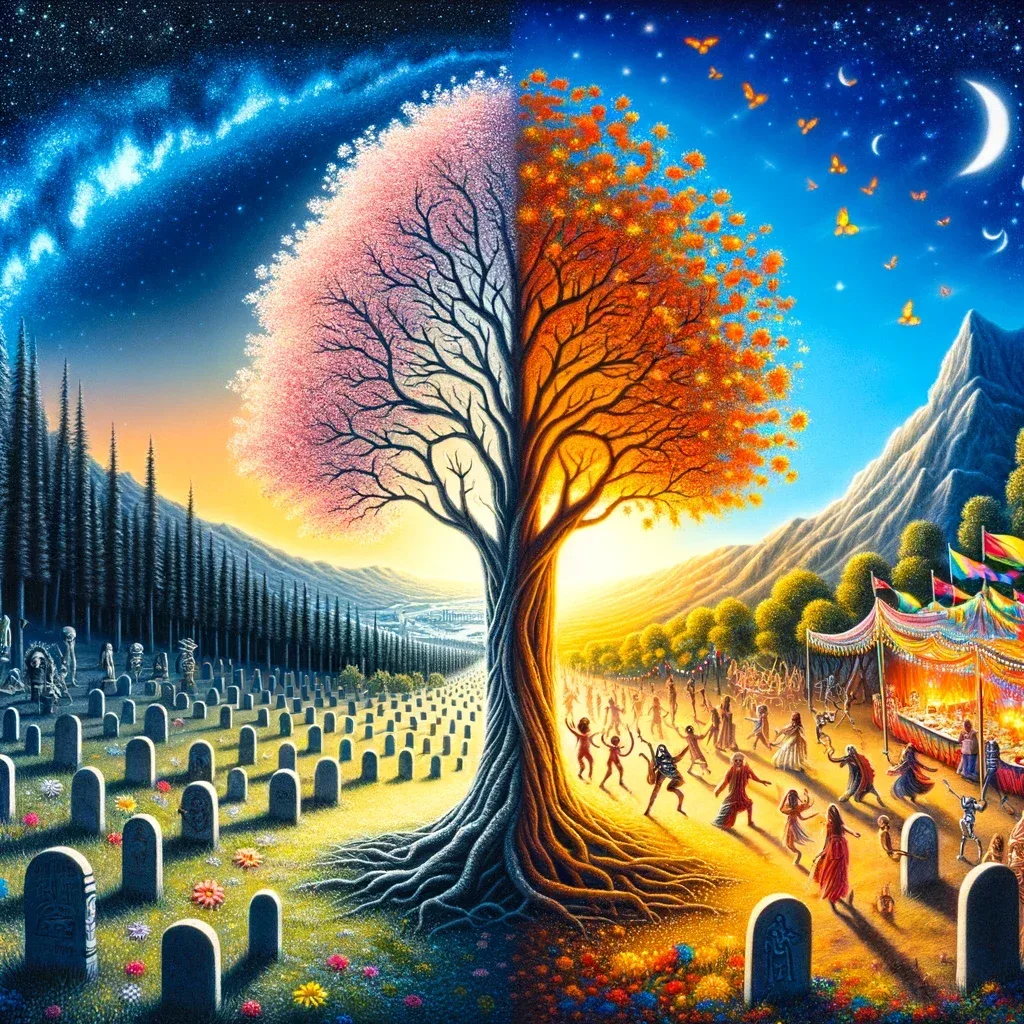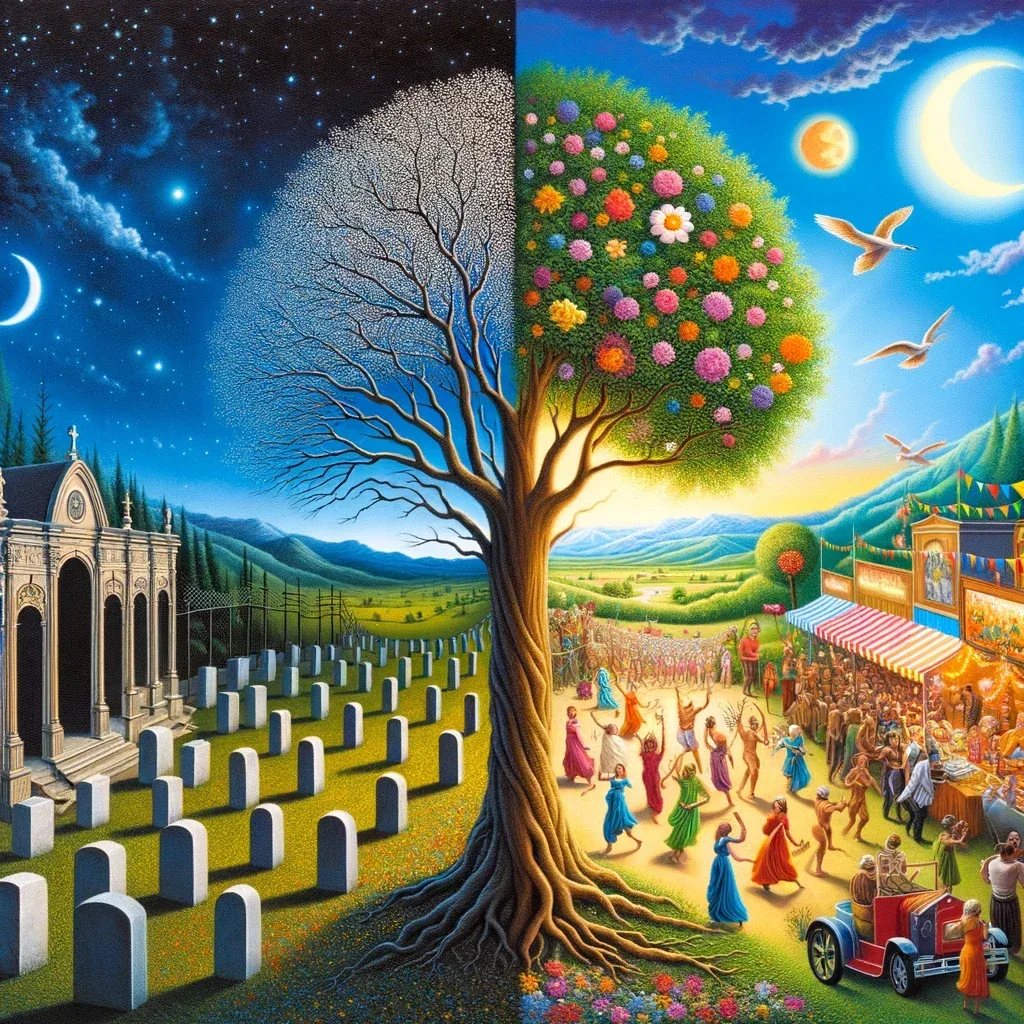Understanding the ephemerality of human life has been a topic of consideration and reflection throughout the ages. Two Latin phrases, “Memento Mori” and “Memento Vivere,” encapsulate different, but equally important, reflections on the transitory nature of life and the inevitability of death. These two expressions serve as powerful reminders of the importance of living a full and conscious life.

Memento Mori: A Reminder of Mortality
“Memento Mori”, translated from Latin as “remember that you must die”¹³, is an artistic or symbolic reminder of the inevitability of death³. The concept has its roots in the philosophy of classical antiquity and Christianity, evidencing a long tradition of contemplating mortality as a means to living a more meaningful and virtuous life. The idea is that by keeping mortality in mind, we can live more purposeful lives and avoid wasting our precious time on trivialities.
Origins and Evolution of the Concept
Philosophers of classical antiquity often explored the topic of mortality in their speeches and writings. The concept of “Memento Mori” has permeated funerary art and architecture since the medieval period, serving as a tangible and visual reminder of the finiteness of human life³. The phrase was often used to remind individuals, especially those of great stature or power, that, regardless of their exploits and glories, death is a common fate for all¹.
Artistic and Cultural Manifestations
“Memento Mori” has been a recurring theme in art and literature over the centuries. It is depicted in various art forms, including paintings, sculptures, and literature, serving as a meditation on the transience of life and the inevitability of death. These artistic representations aim to provoke reflection and awareness about the finiteness of life, encouraging a more conscious and purposeful life.
Memento Vivere: An Invitation to Live Fully

“Memento Vivere,” which translates to “remember to live”⁴⁵⁶, is a phrase that serves as a reminder to make the most of life, given the omnipresence of death⁴. Unlike “Memento Mori,” which emphasizes the inevitability of death, “Memento Vivere” encourages people to celebrate life and live each moment with intention and joy.
Meaning and Applications
“Memento Vivere” is often found on tombstones and other memorials as a way to honor the lives of the deceased and encourage the living to continue celebrating life even in the face of loss⁴. The expression promotes the idea that, even in the face of mortality, there is a beauty and joy in the human experience that deserves to be celebrated.
Contemporary Reflections
In the modern world, “Memento Vivere” serves as an antidote to the human tendency to postpone life and happiness until the future. It's a call to live in the present, appreciate each moment, and pursue a life of purpose and joy. Recognition of death should not be a source of fear, but rather an encouragement to live fully.
Intersections and Contrasts

Both expressions, “Memento Mori” and “Memento Vivere,” serve as powerful reminders about the ephemeral nature of life. While “Memento Mori” focuses on accepting mortality as an inescapable truth, “Memento Vivere” emphasizes the celebration of life. Together, these phrases encourage a life of reflection, purpose, and joy, recognizing death as a natural and inevitable part of the human experience.
Conclusion
“Memento Mori” and “Memento Vivere” are two sides of the same coin, each offering a valuable perspective on life and death. By embracing both the inevitability of death and the beauty of life, we can live more fully, consciously, and fulfillingly. The interaction between these two expressions offers a rich tapestry of reflection on what it means to live well in the face of the certainty of death.
(1) “Memento mori” doesn't mean what you think, what this ancient Latin…. https://psychology-spot.com/memento-mori-meaning-origin/.
(2) Memento mori – Wikipedia. https://en.wikipedia.org/wiki/Memento_mori.
(3) What Is Memento Vivere Meaning?. https://h-o-m-e.org/memento-vivere-meaning/.
(4) memento vivere – Latin is Simple Online Dictionary. https://www.latin-is-simple.com/en/vocabulary/phrase/1088/.
(5) memento vivere in English – Latin-English Dictionary | Glosbe. https://glosbe.com/la/en/memento%20vivere.
(6) Memento mori: discover the meaning of this concept. https://www.eusemfronteiras.com.br/o-que-e-memento-mori/.
FAQ: Memento Mori and Memento Vivere

1. What does “Memento Mori” mean?
“Memento Mori” is a Latin expression that translates to “remember that you must die,” serving as an artistic or symbolic reminder of the inevitability of death. The phrase originates from the philosophy of classical antiquity and Christianity, and has been used throughout history to reflect on mortality and live a more meaningful life.
2. What does “Memento Vivere” mean?
“Memento Vivere” translates to “remember to live” and is often used to remind people to make the most of life, as death is an inevitable reality. The phrase is seen as an invitation to celebrate life and live each moment with intention and joy.
3. How has the concept of “Memento Mori” evolved over time?
The concept of “Memento Mori” has permeated funerary art and architecture since the medieval period, serving as a tangible reminder of the finiteness of human life. It was often used to remind individuals, especially those of great stature or power, of the inevitability of death.
4. How do “Memento Mori” and “Memento Vivere” contrast?
“Memento Mori” focuses on accepting mortality, while “Memento Vivere” emphasizes the celebration of life. Both serve as powerful reminders of the ephemeral nature of life, but from opposing perspectives, encouraging a life of reflection, purpose, and joy.
5. How is “Memento Vivere” represented on tombstones and memorials?
“Memento Vivere” is often found on tombstones and other memorials as a way to honor the lives of the deceased and encourage the living to continue celebrating life even in the face of loss.
6. How is “Memento Mori” portrayed in art?
“Memento Mori” is a recurring theme in various art forms, including paintings, sculptures, and literature, serving as a meditation on the transience of life and the inevitability of death.
7. What are the philosophical origins of “Memento Mori”?
The philosophical origins of “Memento Mori” date back to classical antiquity and Christianity, where reflection on mortality was seen as a means to living a more virtuous and meaningful life.
8. How is “Memento Vivere” relevant in the modern world?
In the modern world, “Memento Vivere” serves as an antidote to the human tendency to postpone life and happiness until the future, encouraging people to live in the present and appreciate each moment.
9. How can these expressions impact daily life?
Both expressions encourage a life of reflection, purpose, and joy, recognizing death as a natural and inevitable part of the human experience. They can serve as daily reminders to live more fully and consciously.
10. How can accepting death lead to a fuller life?
Acceptance of death, as encapsulated in “Memento Mori,” can lead to a fuller life by avoiding wasting time on trivialities and living more purposefully and consciously.






